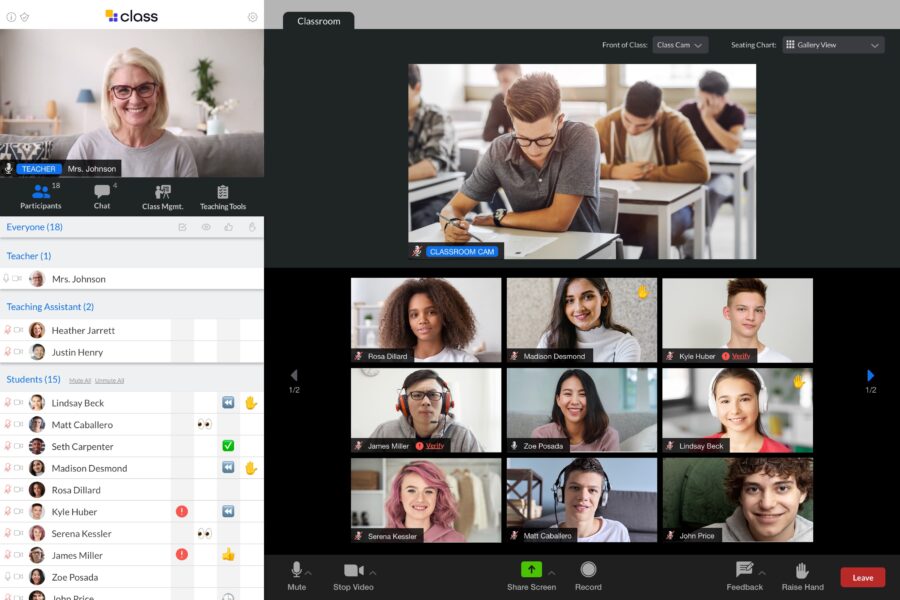


It’s not easy teaching hybrid classes, but it’s a format here to stay at every level of K-12 education. While teachers were thrust into this environment at the beginning of the pandemic, they’ve learned a lot since. Districts have also provided resources ranging from technology options to training and support.
When asked what they consider the most significant challenge with hybrid classes, it’s not surprising that most teachers say it’s keeping students engaged. It’s tough enough to capture and keep students’ attention in the classroom, so it’s hardly surprising that there would be additional challenges in a virtual environment without that physical presence.
In-person, it’s easier to interpret if students are engaged. However, in a remote environment, instructors lose some of those cues, so how can we translate those virtually?
“Number one is participation,” says Dr. Catherine Zeisner, Assistant Professor, DELA – Educational Leadership & Administration, School of Education at Gonzaga University. “Are their cameras on? Is the work getting done? Ask questions, and communicate after class.”
Elfreda Massie, Ph.D., VP, K-12 Strategy at Class, and a former school superintendent, says that another sign of engagement can be “if they’re not leaving the online environment to do other things.” Raising their hands and offering feedback—either verbally or through the chat function or polls are some other indicators teachers can monitor.
Despite the potential for distractions and other challenges, teachers have found that hybrid, or remote, learning offers new opportunities for them and their students.
Hybrid and virtual classes have offered the opportunity to give students “insights into your world,” Massie says. They can see where you live. They can see your pets. Sometimes they might even see your family members! So while privacy needs to be respected, there can also be opportunities for meaningful connections.
Another opportunity that hybrid or remote classes provide is tracking engagement more precisely. In the physical classroom, it can be challenging, if not impossible, to track how often and how long students were attentive, or who asked or answered the most questions. In the online world, though, there are tools that can automatically track these things.
One significant unintended positive impact of learning in a hybrid world for some students has been freedom from anxiety and even bullying. In the online world, says Massie, “there are fewer microaggressions.”
Hybrid classes also offer more access to students and teachers who may have to travel long distances—or even get “dressed up” for class. Participation asynchronously also supports the flexibility to work, pursue leisure pursuits and interests, or attend classes while traveling. Consider also that some students may be incarcerated or hospitalized; online learning provides them with an opportunity to continue their education.
Wherever they are, and whenever they engage, “we can,” says Massie, “connect students worldwide.”
Students haven’t overlooked these new opportunities and benefits—68% say they would prefer a hybrid learning option post-pandemic; 94% of high school students expect their college classes to have a virtual component.

With engagement as the top challenge, technology options in the virtual environment have emerged to offer various tools to involve students in the learning process, from brief polls to whiteboards and jam boards, to videos, formative assessments, chats, small group breakouts, and more.
It’s essential, says Zeisner, to make connections and create trust with students right off the bat. This, she says, can be done by creating a safe and predictable learning environment—no surprises. As a result, students come to know what to expect—and what your expectations are. And, she suggests, sometimes it can be helpful to let students take control.
“Students can lead the class,” Zeisner says. “They can be the host.” But, she says, “what you’re saying is ‘I trust you’ when you give them that opportunity.”
Those connections can continue throughout the semester, says Massie, who recommends offering opportunities for students to connect and engage with you outside of class time. For example, you might hold office hours where students can drop in to talk. Or have a “coffee time,” where you’re available and willing to engage around whatever students might be interested in.
Finally, Massie recommends making learning fun. One tactic that can be very engaging is to hold competitions of various kinds, she says. “We all love fun competition and opportunities to get awards—an extra star, or whatever it is.”
Learning also needs to be relevant and valuable, Zeisner notes. If they can read a book or learn the same material on Google, she says, it’s not surprising that they might think, “why do I need to come to class?” She has combatted this and provided reasons to do things like asking students to write ‘exit tickets’ at the end of every class session and then giving awards at the beginning of the next class based on that input.
Yes, there are challenges in the virtual world, but there are also some significant benefits, as we’ve seen. Teachers are gaining experience in the hybrid world and leveraging their own and others’ best practices to effectively engage with students at all levels in classes of all kinds. Technology can lay the foundation for engagement, but the teachers have learned to adopt that technology in meaningful ways.
To hear the full conversation, watch the recording of Develop Supportive Strategies for Hybrid Teaching and Learning.


Get our insights, tips, and best practices delivered to your inbox

Sign up for a product demo today to learn how Class’s virtual classroom powers digital transformation at your organization.

Features
Products
Integrations